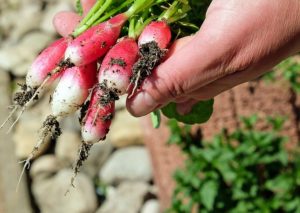Fifty years ago, about 70 percent of the produce found in grocery stores was grown, produced, or processed within 100 miles. Today, the food Americans consume has traveled, on average, 1,500 miles before reaching the plate. What happened to local food in today’s global market?
Movements about local food and “locavore” lifestyles are on the rise. We can probably all agree that “local food” refers to seasonal, fresh, tasty, healthy, and sustainable food. But if asked for the definition of “local food,” what would you say?
As it turns out, there is no official definition of “local food.” Let’s dig into the many ways the concept can be defined.
-
Food miles
Local food can be defined by the distance between where the food was grown and where it is sold or consumed. According to the definition adopted by the U.S. Congress in the 2008 Food, Conservation, and Energy Act2, the total distance that a product can be transported and still be considered a “locally or regionally produced agricultural food product” is less than 400 miles from its origin, or within the State in which it is produced. However, the common definition used by the general population considers food “local” if it was grown within 100 miles or within the state.
If the food travels, it is important that information about the product travels with it to ensure its origin. In many instances, there may also be one intermediary between the farm and the consumer, such as a restaurant or a retail store. But the question remains: how does this intermediary define “local food?”
And does that definition comply with consumers’ expectations? This is where supply chain management comes into play, creating a connected network between partners to share the correct information.
-
Direct sales to consumer
Some people define local food as produce bought directly from the farm, either at the farm itself or at a farmers market. The number of farmers markets has steadily risen, from 1,755 in 1994, to 2,756 in 1998, and up to 5,274 in 2009, according to USDA’s Agricultural Marketing Service3.
Farm to school programs are also getting more traction around the local food movement. The number of programs have increased to 2,095 in 2009, up from 400 in 2004 and 2 in 1996-97, according to the National Farm to School Network3.
-
Ecology dimension
Still others refer to the characteristics of the environment where the food is grown when defining “local food.” Let’s say, for example, that for a specific region, food is grown in climate A, with soil type B, watershed system type C, and species type D. Any food produced in this same environment would be considered local to that region, even if the food comes from further away.
In the end, consumers will decide what local food means to them. Buying “local food” has become easier in recent years, due to the increase of farmers markets as well as the emergence of new services such as home delivery of local food (i.e. CSA boxes4) and vending machines on farms5 that allow consumers to purchase fresh produce at any time.
Generally speaking, people tend to perceive local food as “better” and prefer purchasing locally, even though risks are still present. But what about processed food or global (i.e. non-local) food? Would we feel better about it if we knew where it came from? Would this knowledge improve people’s perceptions?
However you define “local food,” the growth of this movement increases the number of small farms and small producers on the market, meaning an increase in the number of partners that can be included in a supply chain. With consumers wanting more information on where their food comes from, it is essential to keep a transparent flow of information among all partners in the supply chain.
Sources:
1 Globetrotting Food Will Travel Farther Than Ever This Thanksgiving, Worldwatch Institute. http://www.worldwatch.org/globetrotting-food-will-travel-farther-ever-thanksgiving
2 Food, Conservation, and Energy Act of 2008 , US Congress. 05/22/2008. https://www.gpo.gov/fdsys/pkg/PLAW-110publ234/pdf/PLAW-110publ234.pdf
3 Local Food Systems: Concepts, Impacts, and Issues, Economic Research Service. May 2010. http://www.ers.usda.gov/media/122864/err97_reportsummary_1_.pdf
4 Community Supported Agriculture. http://www.localharvest.org/csa/
5 Vending Machines Sell Farm-Fresh Produce, Ariel Schwartz. 10/9/9. https://www.fastcompany.com/1395939/vending-machines-sell-farm-fresh-produce
This article originally appeared in Asia Food Journal on October 17th 2016











